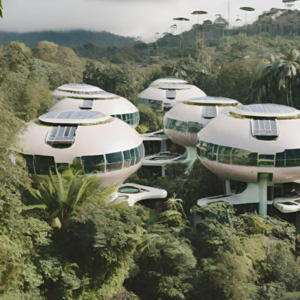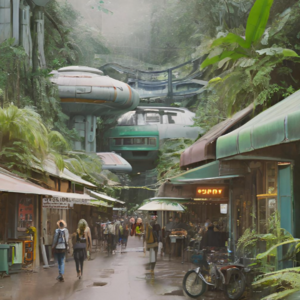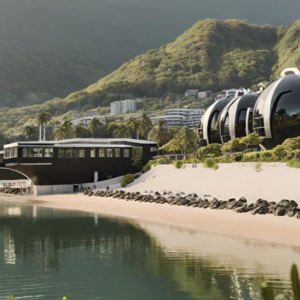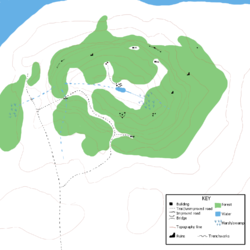Fort Blindshot is a multipurpose post dedicated to the planetary defense of Selen and the maintenance of the planetary garrison. Situated on an exctinct volcanic island in the north Ninasisa Ocean, the remote location is largely separated from any sort of large civilian population and offers easy defense from external forces through the use of turbolaser turrets and interconnected trench and bunker system built across the island. While the island’s population is purely imported (no native villages extant), it currently plays home to the headquarters of House Galeres.
History of Blindshot
Prior to the fort's construction, the island on which it is situated was sparsely and intermittently populated by various small communities of the native Selenian population throughout its more ancient history. Possibly due to the now-extinct volcano's activity at the time, the island lay derelict for much of its otherwise uneventful history. As a result, the island likewise has no historical name, save for its coordinates on maps of Selen.
Following the the destruction of many of Clan Arcona's military assets by the opening attacks of the Collective, the Twelfth Great Jedi War, as well as a brief counterattack by the Collective that ended in a resounding Arconan victory, the Clan was forced to reconsider its military situation at home as much as with its reorganized military. As Estle City was considered particularly vulnerable, and recognizing a need for an easily defensible staging ground, Arcona decided on the previously mentioned island to establish a large-scale base. Lacking a proper home at the time, House Galeres requested and was granted headquarters in the burgeoning military administrative sector of the fort. In honor of the recently presumed-deceased Miraluka, Consul Atyiru, the name "Blindshot" was proposed and approved for the base's designation.
Since then, Fort Blindshot has served on multiple occasions as Selen's quick reaction force, conducting peacekeeping operations as well as planetary security. Notable among these were the hunt for Collective stragglers from the attack on Selen; the post-plague bread-and-labor riots in Estle City; and the defense of civilians on Atolli island when archeological excavations unearthed a horde of ancient and hitherto dormant carnivorous creatures. Likewise, it has also been the consistent staging area for House Galere's reinvestment of Eldar, which was abandoned by Arcona and the DDF at the height of the plague.
Island Districts
Residential, Entertainment, & Commercial Districts
 The outside appearance of the Hab Units available to both stationed Arconans, their families, and civilians alike.
The outside appearance of the Hab Units available to both stationed Arconans, their families, and civilians alike.
The lowlands that dominate the western and southern portions of the island are dedicated to the housing and basic needs of those stationed on the island, including anything ranging from Habitation Units/Housing to shops and entertainment. The Fort holds not only the Arconans stationed there, soldiers and non-military alike, it also holds enough staffing for infrastructure and logistics as well as security to support those who call Blindshot home.
 Shops line the streets of the residential district
Shops line the streets of the residential districtHousing units are separated into militant, non-militant, and civilian sectors– however each holds the exact same amenities and features as the others. Hab units come in several different layouts, accommodating single persons households as well as large families. Each unit holds a main gathering room, a well built kitchen with full appliances, one to three bathrooms, and up to five bedrooms. Some of the habitation units boast up to two floors, though most of the spheres only hold one floor with the addition of a loft space. The housing units are held on raised platforms to help prevent wildlife and weather hazards, each unit holding a landing pad for small spacecraft (up to a Y-wing in size) and solar panels for energy needs.
The streets of the residential units are lined with smaller shops needed for grocery shopping, small luxuries such as holofics and holomagazines, and small food serving vendors such as coffee shops and takeout food locations. These streets are paved and well lit by lights that are low and warm in spectrum, and fed by nearby solar panels in strategic areas to catch the maximum amount of light through the nearby foliage.
 A view of the entertainment and commercial districts from the shore
A view of the entertainment and commercial districts from the shoreThe rest of the lowlands are taken up by the Entertainment and Commercial Districts. The Entertainment districts hold a multitude of different types of activities for those who call the island home. This includes but is not limited to; a gym, movie theater, arcade, library, planetarium and observatory, botanical garden, and other attractions. After the recent attacks on Selen, Galeres Summit realized that stress levels were higher than normal and morale was at an all time low, and made efforts to add to the stress-relieving activities available in the Fort.
 View of the Entertainment/Commercial Sectors showing the civilian hospital in the background
View of the Entertainment/Commercial Sectors showing the civilian hospital in the backgroundThe Entertainment district spans all the way to the beachfront– where there are beach-side hotels for those who are not staying on the island long-term, water attractions such as water speeders and boats for civilians, and a beachside Putput golf course. This section of the island holds the Fort’s port for water-faring small and civilian craft.
The Commercial Sector holds the rest of the buildings needed for infrastructure and support services. The island’s civilian and non-military hospital, school, office buildings for officers and civilians, shops for larger purchases of supplies/furniture/groceries, restaurants, post office, military police post, transportation services, and other infrastructure and support buildings are found in this sector.
The streets in this sector wind along the natural landscape and offer footpaths for those who do not want to take the transportation offered. Benches, trash disposal units, and foliage line these streets where necessary. A few sites in this sector offer gorgeous views of Selen’s oceanscape from cliff faces and lower-lying mountains.
Training Areas & Ranges
The foothills that comprise the eastern third of the island, running along the coast from south to north, are dedicated to various firing ranges: anything from small arms to artillery and air-to-ground targetry. Starting nearest the habitation district in the south are the smaller items that most bases would not do without. A multitude of structures serve as classrooms and training facilities for the garrison, including tactical training simulators to mock cockpits for flight training.
Further up the strip of seaside land are the ranges. This includes a large obstacle course, full of ropes for swinging, crawling, and crossing; as well as a myriad of wooden barriers that must be surmounted; and no course would be complete without the mud pit with the ceiling of criss-crossing lines of barbed wire. From there are ranges that face out into the sea — generally used for gunnery for tanks and other big guns — and others that point toward the extinct volcano. These latter ranges use a series of energy-projection arrays to materialize targets for soldiers to engage with their rifles. After all, where blasters are involved, an energy barrier is cheaper to maintain than replacing transport-loads of flimpy targets.
Several ranges are large enough to facilitate a whole battalion’s movement through them for live-fire exercises, incorporating various types of droid and holo-targets in both open battlefields and mock villages or cities. While forestry is scattered throughout, the dominating features of this part of the island are the rolling hills that serve as much as a backstop to prevent shooting their fellow AAF troops as it does to create tactical complications for the large-formation leaders, who have to factor the terrain into their planning.
The Caldera
 A crude topographical map of the extinct volcano showing the locations of the various training and defensive structures scattered throughout
A crude topographical map of the extinct volcano showing the locations of the various training and defensive structures scattered throughout
The northwestern third of the island, the crater area of the long inactive volcano, is used to familiarize troops with a wide variety of terrain: from rugged uphill climbs, through forest, and down into the caldera valley where there are scattered streams, small marshes, and a small centralized lake. Rocky outcrops commingle with trees and soft earthen slopes to create a kaleidoscope of land, inhabited by equally varied, though small and generally harmless wildlife.
Throughout the wooded areas are derelict buildings and small fortifications to replicate some of the smallest and older habitations on Selen. Mock trenchworks and hidden bunkers are used as fake “enemy” habitations for training, while a few scattered “villages” slumber among the trees and flinty rocks. Down in the valley, among the open fields, lies a mock town, set up for troops to train in urban combat as well as, when roleplayers are available, conducting civilian support operations.
The town, butted up against the north side of the lake, is still relatively small, comprised of only a few dozen buildings of various sizes, and generally split down the middle by a central lane of broken pavement and packed earth. At the far western end of this road is the largest building of the village: a U-shaped structure three stories high, meant to represent a municipal administration structure. It is accordingly filled with offices, desks, and some of the better interior decorating compared to that of the other buildings.
Active defense positions are camouflaged and scattered around the area as well, filling in what would otherwise be blind spots in the defensive net. These laser and turbolaser turret positions are placed both inside and outside of the caldera, meshing the camouflage of the trees and vegetation with the naturally dominating height and angles of the terrain. Many are located close to the trenches used for training as a redundancy measure, as AAF troops would most assuredly occupy those same trenches to fend off a seaborne assault.